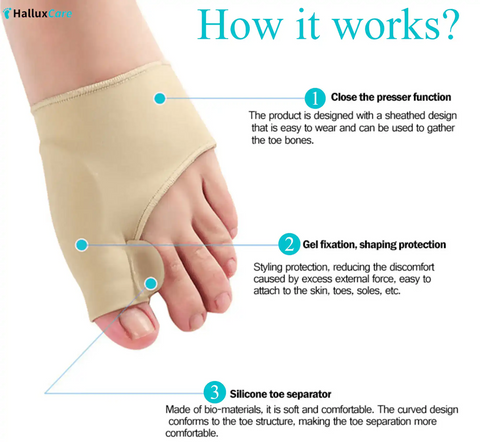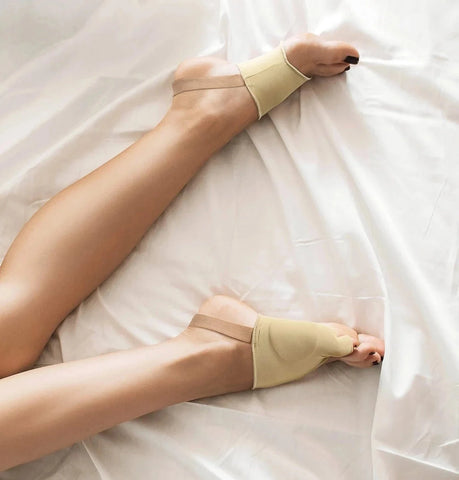Understanding Neuroplastic Pain in Bunions: When Your Brain Learns to Hurt
Bunions often cause foot pain, but sometimes the discomfort worsens not because of more damage, but because the brain changes how it processes pain signals. This is called neuroplastic pain, where your brain "learns" to feel pain even without new injury. Understanding this can help you manage bunion pain better.
Key Takeaways
- Neuroplastic pain occurs when the brain amplifies pain signals despite little or no new physical damage.
- Bunions (hallux valgus) and bunionettes (tailor’s bunions) can cause this type of pain, especially after becoming aware of the condition.
- Conservative treatments such as orthopedic sleeves, proper footwear, and mindful exercises can reduce pain and improve comfort.
- Wearing wide, comfortable shoes with a low heel and soft materials helps reduce pressure on bunions.
- Regular foot exercises and relaxation techniques can retrain the brain’s response to pain.
- Consult a podiatrist if pain persists or worsens despite conservative care.
What Is a Bunion (Hallux Valgus) and Bunionette (Tailor’s Bunion)?
A bunion is a bony bump that forms at the base of the big toe, causing the toe to lean toward the second toe. This misalignment is called hallux valgus and often leads to pain and swelling. A bunionette, or tailor’s bunion, forms on the outside of the foot near the little toe. Both can cause discomfort and affect walking.
Glossary of Terms
- Bunion (hallux valgus): A deformity at the big toe joint causing the toe to angle inward.
- Bunionette (tailor’s bunion): Similar bump on the outside of the foot near the little toe.
- Toe spacers: Devices placed between toes to improve alignment.
- Bunion sleeves: Soft braces that cushion and support the bunion area.
- Orthoses: Custom or over-the-counter foot supports to correct alignment.
Symptoms of Bunions and When to Seek Care
Typical signs include:
- Visible bump on the side of the foot.
- Redness, swelling, or tenderness around the joint.
- Pain during walking or wearing shoes.
- Limited movement of the big toe.
- Increased sensitivity or burning sensations.
Seek professional care if:
- Pain becomes persistent or severe.
- Walking or daily activities are impaired.
- You notice signs of infection (redness, warmth, pus).
- Conservative treatments fail to relieve symptoms.
Understanding Neuroplastic Pain and Its Role in Bunion Discomfort
Neuroplastic pain happens when the brain “learns” to maintain a pain response even after the original cause has improved or hasn’t worsened. Studies show that chronic foot pain, including from bunions, can involve these brain changes [1,2].
- The brain may amplify pain signals after you become aware of the bunion.
- Touch or pressure may feel more painful than expected.
- Pain may persist despite rest or treatment.
Recognizing this can prevent frustration and guide you toward holistic pain management.
Conservative Management Options and Product Guidance
Supportive devices and lifestyle changes are key to managing bunion pain and neuroplastic pain:
- Orthopedic Bunion Sleeves: These medical-grade sleeves provide gentle toe realignment and cushion the bunion, reducing pressure and irritation. They also help calm the brain’s pain response by stabilizing the area.
4.9 ⭐⭐⭐⭐⭐ ( 1843 reviews )
- Tailor’s Bunion Bunionette Pain Relief Sleeves: Specifically designed for bunionettes, these sleeves provide protection and correction to the outer foot.
- Skin Care with Soothing Oils: Using moisturizing and anti-inflammatory oils like Jamaica Black Castor Oil can soothe irritated skin around bunions and support overall foot health.
Explore the Jamaica Black Castor Oil Soothing Oil for added comfort and skin nourishment.
Fit and Footwear Tips for Bunion Relief
Choosing the right shoes is essential for managing bunion discomfort and preventing worsening:
- Wide Toe Box: Shoes with ample space reduce pressure on the bunion and toes.
- Soft, Stretchable Materials: Leather or mesh that adapts to foot shape prevents irritation.
- Low Heel Height: Heels under 2 inches reduce strain on the forefoot and big toe joint.
- Avoid Pointed Toe Shoes: Pointed footwear compresses toes and exacerbates bunion pain.
Proper footwear combined with orthotic supports can slow bunion progression and ease pain [3].
Exercises and Daily Routines to Manage Bunions and Neuroplastic Pain
Incorporate these practical steps:
- Toe Stretching and Spreading: Use toe spacers to gently separate toes and improve alignment.
- Big Toe Flexion and Extension: Move the big toe up and down to maintain joint mobility.
- Foot Rolling: Use a tennis ball or foot roller to relax foot muscles and reduce tension.
- Mindfulness and Relaxation: Practice breathing exercises and meditation to reduce pain sensitivity by calming the nervous system.
- Gradual Activity: Avoid sudden increases in walking or exercise intensity to prevent aggravation.
How to Use Orthopedic Bunion Sleeves: Simple Routine
- Slide the sleeve over your foot, positioning the padding over the bunion bump.
- Adjust to ensure a snug but comfortable fit without cutting off circulation.
- Wear throughout the day, especially during walking or shoe wear.
- Combine with proper footwear and foot exercises for best results.
Frequently Asked Questions (FAQs)
Are toe spacers safe for bunions?
Yes, toe spacers are generally safe and can help realign toes, reduce friction, and relieve bunion pain when used properly [4].
How long should I wear toe spacers daily?
Start with 15–30 minutes per day and gradually increase as tolerated. Excessive use may cause discomfort, so listen to your body.
What’s the difference between a bunion and a tailor’s bunion?
A bunion (hallux valgus) affects the big toe joint, causing it to lean inward. A tailor’s bunion (bunionette) forms on the outside of the foot near the little toe.
Do bunion sleeves help with shoe comfort?
Yes, sleeves cushion the bunion, reduce pressure, and can make wearing shoes more comfortable by preventing irritation.
When should I see a podiatrist?
Seek professional care if pain worsens, limits daily activities, or does not improve with home treatment.
Can I run or play pickleball with a bunion?
With proper footwear and support, many people continue activities like running and pickleball. However, reduce intensity if pain increases and consult a podiatrist for advice.
Final Thoughts: Can Bunion Pain Be Unlearned?
Neuroplastic pain shows how the brain influences chronic discomfort. By combining physical support, footwear adjustments, exercises, and mindful practices, you can reduce both mechanical and brain-driven pain sources. This holistic approach empowers you to manage bunion pain more effectively and improve your foot health.
Recommended HalluxCare Bunion Products for Relief and Care
If you're looking for relief from bunion pain, consider using the Orthopedic Bunion Pain Relief & Correction Sleeve, which provides support and helps to alleviate discomfort.
For additional protection, the Tailor's Bunion Bunionette Pain Relief Protection Sleeves are designed to offer comfort and protection for bunionette pain.
To nourish and soothe the skin around bunions, as well as to promote healthy hair, consider the Jamaica Black Castor Oil Soothing Oil. Known for its moisturizing and anti-inflammatory properties, it helps alleviate discomfort around bunions and supports hair growth and scalp health.
Sources
- American Orthopaedic Foot & Ankle Society (AOFAS). “Bunion (Hallux Valgus).”
- National Institutes of Health (NIH). “Neuroplasticity and Pain.” https://www.ncbi.nlm.nih.gov/pmc/articles/PMC4361087/
- MedlinePlus. “Bunions.” https://medlineplus.gov/bunions.html
- American Podiatric Medical Association (APMA). “Toe Spacers and Bunion Relief.” https://www.apma.org/




